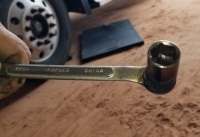The clutch of a semi tractor needs periodic adjusting there are generally 2 separate adjustments to the clutch.
the first is the simple linkage adjustment which is in many cases rarely needs to be adjusted after installation of new disks and pressure plates, once properly adjusted This adjustment establishes the proper travel of the foot peddle, the other and more important adjustment is located on the pressure plate, this adjustment not only establishes the proper travel of the foot peddle but in addition manages the balance between disengagement of the clutch and the engagement of the input shaft brake which slows the transmission input shaft to aid in the shifting of the gears. Or completely halts the input shaft to allow the transmission to be put in gear when first starting off from neutral.
For this adjustment depending on the make and model can require a special tool.
On many lighter duty and older design pressure plates this is done by removing a retaining bolt and a forked keeper then the adjusting ring inside of the pressure plate is rotated by a special tool bolted into the retaining bolt hole then used to advance the pressure ring.
On newer and heavier duty clutches another way of making this adjustment is to use a box end wrench to turn the adjusting bolt someone depresses the clutch then the mechanic makes the adjustment by turning the head of the bolt while adding force to depress the locking spring with the end of the wrench,
many times it takes a double offset wrench to have enough clearance to accomplish this
So what I did not having the proper size offset box end wrench was to weld a short 6 point socket to the box end of the wrench.
I could have just as well used a socket and a piece of flat stock in leu of the wrench but having both a socket and box end wrench which fit into the sacrificial category this was what I came up with




 LinkBack URL
LinkBack URL About LinkBacks
About LinkBacks




 Reply With Quote
Reply With Quote


Bookmarks